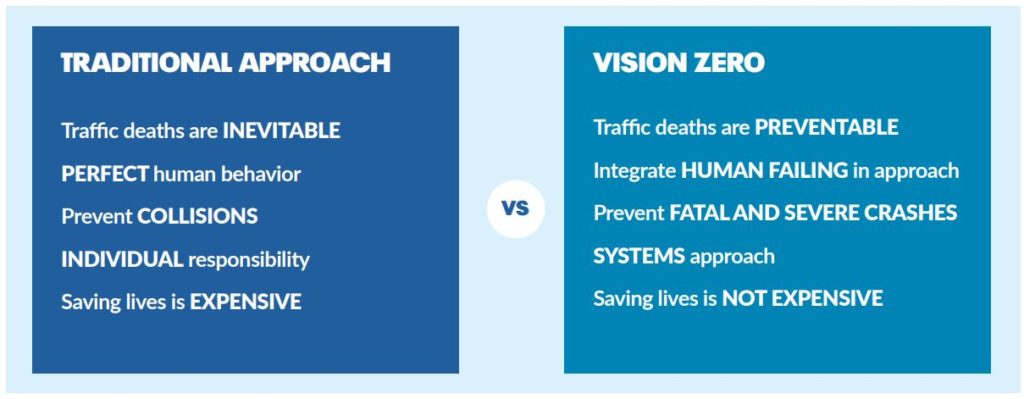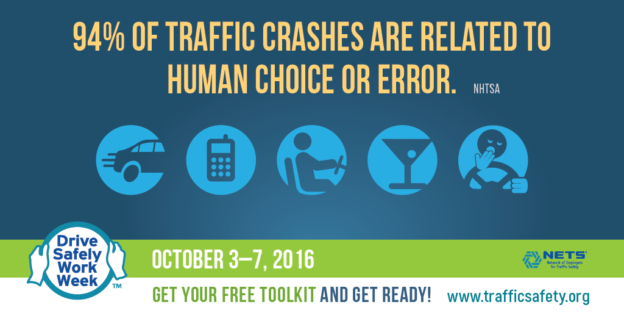The 12 Days of Safety Myths
December 19, 2018
By Don Kostelec
“About 94 percent of serious crashes are due in part to
frequent and predictable driver errors.”
– The Road to Zero, National Safety Council, 2018
How many times have you heard that go-to excuse from transportation agencies?
Can we have a safer place to cross the street? “Well, 94% percent of crashes are caused by human error. If everyone would just obey the law, your crossing would be safe.”
“If everyone would just…”
If everyone would just obey the speed limit. If everyone would just use a crosswalk. If everyone would just stop texting and driving. If everyone would just stop drinking and driving. After all, since 94% of crashes are caused by human error, we’d be a lot safer if everyone would just…
With organizations like the National Highway Traffic Safety Administration (NHTSA) spouting the 94% claim with each new annual fatalities report, the media grabs it and runs with it.
But even NHTSA misquotes itself. When you look into their reports that are the genesis of that statistic, NHTSA says that 94% figure represents the last critical reason in a crash. Crashes are much more complex than one final decision, which is why NHTSA says that last critical reason, thus that 94% figure, “is not intended to be interpreted as the cause of the crash .”
Still, we hear it at conferences all the time. Proponents of autonomous vehicles use the mantra to tout how their vehicles take human error out of the equation; since autonomous vehicles remove human error it means 94% of serious crashes will magically disappear.
We must stop touting this statistic, as it is pure bunk.
Earlier this year I retweeted this from Bloomberg’s feed:
David Ward, the Secretary General of the Global New Car Assessment Programme (Global NCAP), replied by saying the 94% claim was “A cliche that is wrong and misunderstands the complex causation of road crashes. Original NHTSA research only showed human error was last identifiable cause.”
That revelation to a traffic safety organization in the United States is like telling a five-year old that Santa Claus doesn’t exist…on Christmas Eve!
The 94% claim is their raison d’etre, after all. It drives their funding pursuits and grant programs aimed at trying to perfect human behavior when on the road. It propels them to suggest that education and enforcement are the key to reaching zero deaths on United States roadways.
Again, it’s bunk.
I reached out to David Ward to learn more and started a deeper dive into the issue. At the same time I was developing a Vision Zero workshop for the United Way of Southwest Idaho and a project we are doing for them on traffic safety and physical activity in Caldwell.
Crash Survey & Investigation
The first indication that the 94% claim is misleading is that it is derived from documents like this one from NHTSA: Critical Reasons for Crashes Investigated in the National Motor Vehicle Crash Causation Survey (2015).
The opening paragraph of the report states “The critical reason, which is the last event in the crash causal chain, was assigned to the driver in 94 percent (±2.2%)† of the crashes.”
Read that again…And again…Now, read it again.
Do you see how loaded that statement is? Yes, it’s technical, very technical. It’s that way because it involves statistical analysis of a set of crash factors in the moments right before a crash, moments when many factors are involved.
“The critical reason, which is the last event in the crash causal chain…”
The last event. Not the entirety of events. Not the road’s engineering itself that may have caused the human error, or the over-arching flaws in the vehicle’s engineering or poor maintenance by the driver. The media reports and conference sessions never mention that.
The last event–the “oh, sh*t” moment–“… was assigned to the driver in 94 percent (±2.2%)† of the crashes.”
Consider this scenario as you think of the “critical reason.”
- A driver is moving at 40 mph on a road posted at 30 mph, but engineered to be forgiving to the driver at 40 mph. The driver, who recently traded their Prius for a Ford Excursion, then makes a high speed turn at a signalized intersection onto a road with corner radii designed to allow high speed turns. The light is green for the driver, which means the person crossing the street parallel to the driver’s previous direction has the WALK signal as the driver turns across their path. It’s at night on a poorly-lit intersection with only a transverse line, low visibility crosswalk. The person on foot is hit. The velocity and height of the vehicle is such that the impact is fatal to the person in the crosswalk.
The “critical reason” for the crash would be cited as the driver’s error in failing to yield to the pedestrian, if they can prove that. If not, the “critical reason” might be pedestrian error. In either case, it doesn’t account for the numerous engineering factors of the road and vehicle that made that situation fatal.
In that all-too-common road design scenario, we’ve set up both the driver and the pedestrian for catastrophic failure.
David Ward sent me to NHTSA’s 2008 Motor Vehicle Crash Causation Study, a report given to the US Congress.
It states:
- “However, the critical event, the critical reason underlying the critical event, or the associated factors should not be interpreted as the cause of the crash.”
If every traffic safety officer would just read that.
That’s like telling your five-year old that Santa Claus, the Easter Bunny, the Tooth Fairy, and the Great Pumpkin don’t exist at the same moment they are blowing out the candles on their birthday cake.
This sentence is repeated in the 2015 report I linked above under a section titled “Critical Reasons for the Critiical Pre-Crash Event.

David Ward’s email made this statement about how this erroneous claim is compounded in autonomous vehicle discussions. Because 94% of crashes are caused by human error, autonomous vehicles will solve our problems, right? “What we know is that crashes are the result of multiple factors, and a crash is the culmination of multiple unlucky or unfortunate events. Trying to tackle them by a new form of automated silver bullet is as bad, in my opinion, as relying on driver education was back in the 1950s and 60s,” wrote Ward.
In his recent interview with The World Resources Institute The City Fix, Ward said, “There are technologies that we know work today, in vehicle safety for instance…and there’s a danger that the debate about autonomy will distract us from these systems which are available here and now.”
Crash Investigations
We also know that crash investigators aren’t trained or empowered to look at road design or vehicle maintenance flaws as contributory to a crash, especially when it involves a person who walks or bikes.
Police reports commonly identify the color of clothing that the pedestrian or bicyclist was wearing, but they never identify whether or not the vehicle had adequate headlights for lighting up the road ahead. They don’t examine the maintenance records of the vehicle to see if the owner kept its brakes in proper working order. They don’t identify turning radii, vehicle lane width, lack of high visibility crosswalks, ADA non-compliance, or inoperable pedestrian push buttons as contributory to the crash.
I’ve been on post-fatality road evaluations with engineers. Their approach is this: Does it meet our design “standards”? If so, then they can check the box, move along, and tell themselves they did nothing wrong. “It meets standards, so if everyone would just…”
Even though many pedestrian and bicyclist crashes occur a night, the engineers don’t work during those hours so they tend to investigate the crash location during the day. Does the intersection or roadway have adequate lighting? They look up, shield the sun, see a light pole, and check that box, too.
Chalk it up to human error. “If everyone would just…hey, let’s grab lunch!”
Enter True Vision Zero
I started this post with that quote from National Safety Council for a reason. Even though they don’t acknowledge the background fallacy of the 94% percent claim, they recognize that perfecting human behavior is not the path to reducing traffic deaths. In trying to paint a picture of the United States, circa 2050, they state:
- “Given that it’s impossible to eliminate human error entirely, planners and engineers began thinking of ways to design roads and vehicles to accommodate human error to make the entire system safer.”
Recognizing this reality is the largest hurdle to getting the engineering profession to truly adopt a Vision Zero safe systems approach. This doesn’t mean we abandon education or enforcement. But it’s unfair for highway agencies and traffic engineers to out-source safety to education and enforcement by hiding behind the 94% claim. It’s unfair to engineer a road so it sets the driver, the bicyclist, the pedestrian up for tragic results due to the most minor mistake.
Vision Zero is based primarily on speed management. It’s the speed–the transfer of kinetic energy from a vehicle to a human–that leads to severe and fatal outcomes of crashes. This is especially true of vulnerable road users.
Research cited in the article “Swedish Vision Zero policies for safety – A comparative policy content analysis” found that “deficiencies in the road traffic environment and vehicle system are the main cause of approximately 63% of all deaths.” This was from a study that comprehensively examined the influence of the road user, the vehicle, and the road–something that’s doesn’t appear in NHTSA’s analyses.
The Vision Zero Network gets it. They recently released a Vision Zero Core Elements handout in cooperation with the Institute of Transportation Engineers.
In it they state: “Vision Zero emphasizes a Safe Systems approach,which acknowledges that people make mistakes,and focuses on influencing system-wide practices,policies, and designs to lessen the severity of crashes.” They also acknowledge the role that speed plays in severe and fatal crashes, “Travel speeds are set and managed to achieve safe conditions for the specific roadway context and to protect all roadway users, particularly those most at risk in crashes.”
If everyone would just understand safe systems approaches, then we’d truly have safer streets. I’m sorry I blew out your candles, highway safety officials. Santa Claus doesn’t exist!

Previous Posts in the 12 Days of Safety Myths Series:

